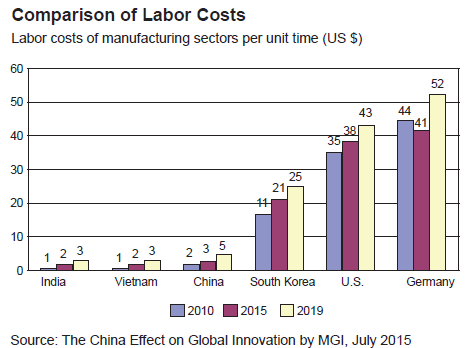China's innovation benefits the world
 0 Comment(s)
0 Comment(s) Print
Print E-mail China Today, July 4, 2016
E-mail China Today, July 4, 2016
Inexhaustible Driving Force of a Vast Consumer Market
China's consumer market - already enormous and ever on the increase - generates endless impetus for enterprise innovation, since booming consumer demand impels companies to commercialize the fruits of their innovation and scale up their manufacturing processes. The domestic consumer market is expanding in China and displaying the momentum of a rising demand in the wake of economic development and consequent increases in disposable income. China has become a huge consumer market for smart phones, with 750 million users - 4.2 times as many as in the U.S., and there are 650 million Internet users in China - 420 million more than in the U.S. China is moreover the world's largest consumer market for PCs, air conditioners, fridges, microwave ovens, and household washing machines. Relying on this large market, Chinese companies such as Baidu, Alibaba, Tencent, and Haier have rapidly become leaders, not only in the local market, but also in the world, in the fields of, respectively, Internet searches, e-commerce, Internet games, and household appliances. This thriving market demand in turn also benefits overseas investors in China and stimulates their growth. For example, confronted by falling demand for small household appliances in developed countries, Phillips adjusted its strategy to relocate the production headquarters of a vacuum cleaner, juicer and electric rice cooker to China. Its sales of small household appliances have attained remarkable achievements in the robust Chinese market, with an increase of 56 percent in 2014 over 2012.
Rich Labor Resources, Lower Innovation Costs
Manpower is a decisive factor in manufacturing and creation. Despite the potential challenges posed by an aging population, China remains a country with an abundance of labor. At present, a total of 150 million industrial workers are at work in China's manufacturing sector, outnumbering the figures for the U.S. (14 million), Japan (nine million), and South Korea (four million). In addition, a considerable number of high-level talents offer intellectual support for enterprises to engage in innovation, while saving on labor costs. In 2013, 28,700 persons in China obtained their doctorate in science or engineering - a figure that stands at the world's apex.

Although China's labor costs have been on an upward trend in recent years, these are still lower than those of developed countries. MGI estimates that labor costs in China's manufacturing sector will rise from US $2 per hour in 2010 to US $5 per hour in 2019. Though a 2.5-fold increase is no minor change, labor costs in China remain merely 11.6 percent of U.S.'s costs, and 9.6 percent of Germany's (See figure). Thanks to a labor force that is large in number, flexible within the market, cost-effective and well-qualified, China's enterprises are capable of saving on the costs of innovation and accelerating their innovative practices.






Go to Forum >>0 Comment(s)